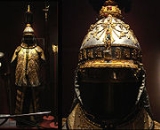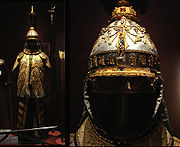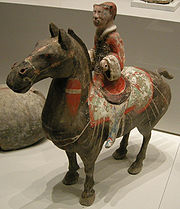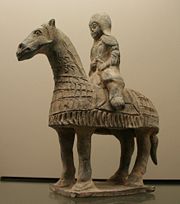
Chinese armour
Encyclopedia

China
Chinese civilization may refer to:* China for more general discussion of the country.* Chinese culture* Greater China, the transnational community of ethnic Chinese.* History of China* Sinosphere, the area historically affected by Chinese culture...
has a long history of armour
Armour
Armour or armor is protective covering used to prevent damage from being inflicted to an object, individual or a vehicle through use of direct contact weapons or projectiles, usually during combat, or from damage caused by a potentially dangerous environment or action...
and weapons development. China has many varieties of armour, but the most were of the lamellar
Lamellar armour
Lamellar armour was one of three early body armour types made from armour plates. The other two types are scale armour and laminar armour.-Description:...
, coat of plates
Coat of plates
A coat of plates is a form of torso armour consisting of metal plates sewn or riveted inside a cloth or leather garment. The coat of plates makes a fairly brief appearance in the history of European armour during the era of transitional armour, during a portion of the 14th century...
, brigandine
Brigandine
A brigandine is a form of body armour from the Middle Ages. It is a cloth garment, generally canvas or leather, lined with small oblong steel plates riveted to the fabric....
and scaled
Scale armour
Scale armour is an early form of armour sometimes erroneously called scale mail consisting of many individual small armour scales of various shapes attached to each other and to a backing of cloth or leather in overlapping rows. Scale armour was worn by warriors of many different cultures as well...
varieties.
Ancient Armor: Shang to Han
Initially, armour was exclusively for nobles. The earliest known armour used by the warriors of the Shang dynastyShang Dynasty
The Shang Dynasty or Yin Dynasty was, according to traditional sources, the second Chinese dynasty, after the Xia. They ruled in the northeastern regions of the area known as "China proper" in the Yellow River valley...
was light plated armour made from turtle shells tied together with cords. Later, bronze and leather armour was introduced, and simple one-piece breastplates, coat of plates
Coat of plates
A coat of plates is a form of torso armour consisting of metal plates sewn or riveted inside a cloth or leather garment. The coat of plates makes a fairly brief appearance in the history of European armour during the era of transitional armour, during a portion of the 14th century...
and lamellar
Lamellar armour
Lamellar armour was one of three early body armour types made from armour plates. The other two types are scale armour and laminar armour.-Description:...
cuirasses began to appear. Most of these were highly elaborate and decorated, and were often very heavy. The majority of noblemen fought mounted on war chariot
Chariot (Ancient China)
The ancient Chinese chariot was used as an attack and pursuit vehicle on the open fields and plains of Ancient China during the Shang The ancient Chinese chariot was used as an attack and pursuit vehicle on the open fields and plains of Ancient China during the Shang The ancient Chinese chariot ...
s, so the weight of the armour was not a major factor in its construction.
After the defeat of the Shang, the Zhou Dynasty
Zhou Dynasty
The Zhou Dynasty was a Chinese dynasty that followed the Shang Dynasty and preceded the Qin Dynasty. Although the Zhou Dynasty lasted longer than any other dynasty in Chinese history, the actual political and military control of China by the Ji family lasted only until 771 BC, a period known as...
used many weapons and types of equipment that originally came from the Shang. However, the Zhou incorporated some of their own different styles of armour. One type was the gé jiǎ (革甲), a sleeveless coat of animal hide formed on a wooden dummy. The hide used was of buffalo
Water Buffalo
The water buffalo or domestic Asian water buffalo is a large bovine animal, frequently used as livestock in southern Asia, and also widely in South America, southern Europe, northern Africa, and elsewhere....
and rhinoceros
Rhinoceros
Rhinoceros , also known as rhino, is a group of five extant species of odd-toed ungulates in the family Rhinocerotidae. Two of these species are native to Africa and three to southern Asia....
. Because of the disappearance of the rhinoceros in the region, buffalo came to be most common material. Another type of armour used by the Zhou was the wei jia, made of boiled leather with a fabric backing. Red lacquer was often used to form a protective layer for most armour used by the Zhou.
Chariots were used extensively during the Spring and Autumn Period. The chariots were mainly used as a shock weapon and a platform for archers. Since the chariot was restricted to flat terrain, charioteers could be defeated when battling well-organized infantry. Shang chariots were often drawn by two horses; later, the Zhou introduced a four-horse chariot. The crew of the chariot was made up of noblemen, so all would have worn armour.
Zhou chariots were protected by leather, and sometimes came with a canopy to protect the crew from the weather, but this was probably removed before going into battle. Chariot horses were protected by a blanket made of animal skins, with tiger skin being most popular, though sometimes horses wore lamellar peytral made of leather, which protected the horses' chests and necks. Chariot use declined during the Warring States Period
Warring States Period
The Warring States Period , also known as the Era of Warring States, or the Warring Kingdoms period, covers the Iron Age period from about 475 BC to the reunification of China under the Qin Dynasty in 221 BC...
, probably because of the introduction of the crossbow and cavalry.

Most infantrymen wore lamellar or coat of plates cuirasses. The lamellar cuirass worn by these men was made of hundreds of small overlapping metal and/or leather plates laced together to make a flexible and light coat of armour. Coat of plates consisted of hundreds of small non-overlapping metal or leather plates stitched or riveted together. Shoulder guards and helmets were often used, but leather caps seem to have been more common for ground infantry.
During much of the Warring States period, most light cavalry units served as skirmishers - thus armour for cavalry was rare, as it was not seen as necessary. Armour for heavier cavalry tended to be lighter than that of the infantry. Cavalry armour was usually constructed entirely of leather, and lacked shoulder protection. However, during the late Warring States era and the dynasties succeeding it, cavalry armour gradually become heavier and more elaborate. (i.e. Heavy Cavalry with full body protection for both rider and horse, ranging from coat of plates to lamellar from the Han Dynasty or elaborate interlocking triangular scales from the Tang and Song Dynasty)


Qin Shi Huang
Qin Shi Huang , personal name Ying Zheng , was king of the Chinese State of Qin from 246 BC to 221 BC during the Warring States Period. He became the first emperor of a unified China in 221 BC...
. Some terracotta warriors wore no armour; it is suggested that most were conscripts playing the role of skirmishers or support troops for the chariots. They are armed with crossbows and were usually placed at the front of formations. Because of the early use of crossbow technology, these conscripts may not have need armour for close fighting, instead adapting more mobile tactics similar to rifle or musket shooting by rows. Of the terra cotta warriors thus uncovered, Pit 1 has approximately 61 percent of the soldiers wearing armour, Pit 2 over 90 percent, and pit 3, being in a command compound, 100 percent.
Traces of black paint on these figures suggest that the Qin
Qin
-Chinese dynasties and states:*Qin , a state of China during the Eastern Zhou Dynasty*Qin Dynasty , which followed Qin's unification of China in 221 BC and ended in 206 BC*Da Qin , Roman Empire, 202 BC to AD 220...
may have used black lacquered plates to form coat of plates
Coat of plates
A coat of plates is a form of torso armour consisting of metal plates sewn or riveted inside a cloth or leather garment. The coat of plates makes a fairly brief appearance in the history of European armour during the era of transitional armour, during a portion of the 14th century...
and lamellar for their armour. Many different styles of armour were found, but examples of armours from ancient China are rare. Qin Shi Huang
Qin Shi Huang
Qin Shi Huang , personal name Ying Zheng , was king of the Chinese State of Qin from 246 BC to 221 BC during the Warring States Period. He became the first emperor of a unified China in 221 BC...
ordered weapons, and probably armour too, to be destroyed by fire. This is likely the reason that so few examples of ancient armour exist today.
After the fall of the Qin in 207 BC came the rise of the Han Dynasty
Han Dynasty
The Han Dynasty was the second imperial dynasty of China, preceded by the Qin Dynasty and succeeded by the Three Kingdoms . It was founded by the rebel leader Liu Bang, known posthumously as Emperor Gaozu of Han. It was briefly interrupted by the Xin Dynasty of the former regent Wang Mang...
in 202 BC. During the Han Dynasty
Han Dynasty
The Han Dynasty was the second imperial dynasty of China, preceded by the Qin Dynasty and succeeded by the Three Kingdoms . It was founded by the rebel leader Liu Bang, known posthumously as Emperor Gaozu of Han. It was briefly interrupted by the Xin Dynasty of the former regent Wang Mang...
, new style of armour such as scale corselet made of leather and/or iron were adopted. During this time period, the primary metal used in armour was iron, and occasionally steel. Early Han soldiers would have used armour and weapons produced during the Qin era. The Western Han army had armour standardized to meet the need. Armour used by the Han included coats of plates; liang-tang, or "double-faced" armour; and lamellar cuirases made of metal or leather that was suspended over the shoulders by cords. This armour was used by both the infantry and the cavalry. A much heavier and more expensive version, consisting of metal plates laced together, was worn by officers.
Shields were used by both infantry and cavalry. These shields were usually made of wood and often reinforced by a metal centre and rim.
Armour for horses began to appear around the end of the Han dynasty, but the earliest armour yet found dates to the year 302 AD. During the Three Kingdoms Period, fully armoured cavalry (armour covering both the rider and horse) were extensively used as shock troops. Early horse armour came in one piece, but later horse armour came in multiple pieces: chanfron (head protector); neck guards; chest guards; shoulder guards; flank pieces; and crupper. Most cavalry served as mounted archers, and sometimes removed their arm protection to use their bows or crossbows.
Medieval armour




Tang Dynasty
The Tang Dynasty was an imperial dynasty of China preceded by the Sui Dynasty and followed by the Five Dynasties and Ten Kingdoms Period. It was founded by the Li family, who seized power during the decline and collapse of the Sui Empire...
and was further perfected during the Song dynasty
Song Dynasty
The Song Dynasty was a ruling dynasty in China between 960 and 1279; it succeeded the Five Dynasties and Ten Kingdoms Period, and was followed by the Yuan Dynasty. It was the first government in world history to issue banknotes or paper money, and the first Chinese government to establish a...
. It is made from a multitude of small pieces of steel that are vaguely shaped like the Chinese character for the word shan (Mountain). This would thus explain its name. The pieces are then interlocked and riveted to a cloth or leather backing. It effectively covers the torso, the shoulders and the thighs while remaining comfortable and flexible enough to allow movement. Also during this time to the early Ming Dynasty, Chinese officers used plate armour, which were culturally decorated, for "important" body parts instead of covering their whole body since too much plate armour hinders their martial arts movement. The "Other" body parts were covered in cloth, leather, lamellar, and/or Mountain pattern. This overall design was called "mingguangjia."
Mail armour was introduced to China when its allies in Central Asia paid tribute to the Tang Emperor in 718 by giving him a coat of "link armour" assumed to be chainmail
Chainmail
Mail is a type of armour consisting of small metal rings linked together in a pattern to form a mesh.-History:Mail was a highly successful type of armour and was used by nearly every metalworking culture....
. China first encountered the armour in 384 when its allies in the nation of Kuchi arrived wearing "armor similar to chains". Once in China mail was imported, with the main source being Persia, but was not produced widely. It was typically the armour of high-ranking guards and those who could afford it rather than the armour of the rank and file, who used the more familiar, easier to produce, and less laborious to maintain brigandine and lamellar armours. These armour types better suited the needs of the Chinese, who had to produce large quantities of armour quickly for their forces in instances of rebellion or external strife.
Late Chinese Armour
By the 19th century, most armour was worn mainly for ceremonial purposes and was an indicator of rank. The kind of armour that was largely used was the brigandineBrigandine
A brigandine is a form of body armour from the Middle Ages. It is a cloth garment, generally canvas or leather, lined with small oblong steel plates riveted to the fabric....
, a type of armour consisting of a leather or cloth garment lined with metal plates inside. Sometimes, the plates were made in different sizes and shapes to maximize protection. The Chinese brigandine comes in five pieces: the vest, pauldron
Pauldron
A pauldron is a component of plate armour, which evolved from spaulders in the 15th century. As with spaulders, pauldrons cover the shoulder area. Pauldrons tend to be larger than spaulders, covering the armpit, and sometimes parts of the back and chest...
s, skirting, underarm, and groin section. By contrast, the Korea
Korea
Korea ) is an East Asian geographic region that is currently divided into two separate sovereign states — North Korea and South Korea. Located on the Korean Peninsula, Korea is bordered by the People's Republic of China to the northwest, Russia to the northeast, and is separated from Japan to the...
n version of this armour is a single piece. Brigandines were first seen in China and Korea in the 12th century AD and were used up to the 19th century. Armour use began to decline after the introduction of firearms, but shields continued to be used. Most Chinese soldiers of the times went without armour of any kind and mostly wore civilian-style clothing.

Etymology
There are two common Chinese translations for "armour:" 甲 (jiǎ) and 鎧/铠 (kǎi). Kǎi, includes the generic character for "metal", (金) as its radicalRadical (Chinese character)
A Chinese radical is a component of a Chinese character. The term may variously refer to the original semantic element of a character, or to any semantic element, or, loosely, to any element whatever its origin or purpose...
, while jiǎ does not, thus implying that jiǎ was not made of metal. Jiǎ itself comes from guījiǎ (龟甲), meaning "tortoise shell" or "ancient armour".
External links
- Brigandine pictures.
- http://www.armourarchive.org/essays/Shanwenkia.pdf

